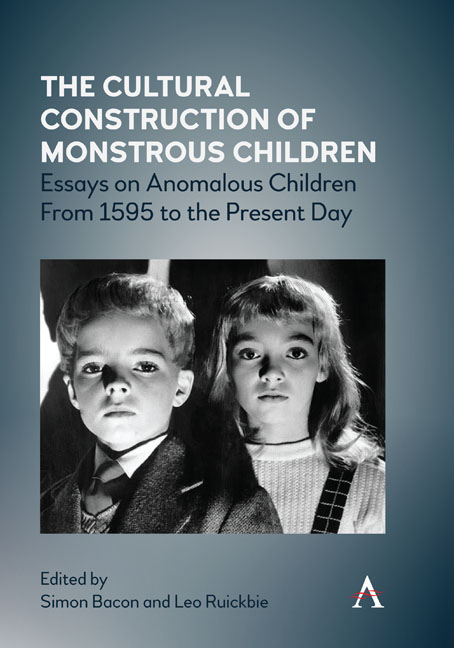 The Cultural Construction of Monstrous Children
The Cultural Construction of Monstrous Children Book contents
- Frontmatter
- Contents
- List of Illustrations
- Acknowledgements
- Introduction
- Part I Historical Case Studies
- Part II Factual Anxiety in Fictional Representations: The Undead Child
- Part III Factual Anxiety in Fictional Representations: The Monstrous Child
- Part IV Cultural Categorization in the Past, Present and Possible Future
- Notes on Contributors
- Index
Chapter Eight - ‘Not a child. Not old. Not a boy. Not a girl’: Representing Childhood in Let the Right One
Published online by Cambridge University Press: 20 January 2022
- Frontmatter
- Contents
- List of Illustrations
- Acknowledgements
- Introduction
- Part I Historical Case Studies
- Part II Factual Anxiety in Fictional Representations: The Undead Child
- Part III Factual Anxiety in Fictional Representations: The Monstrous Child
- Part IV Cultural Categorization in the Past, Present and Possible Future
- Notes on Contributors
- Index
Summary
Introduction
Over recent years a growing body of evidence has demonstrated that it is more accurate to talk of ‘childhoods’ rather than ‘childhood’; that the realities of children's lives are complex, multiple and varied and, therefore, ‘childhood’, as both a discursive construct and a corporeal reality, resists easy categorization. However, despite this realization, the cultural meanings ascribed to childhood and popular representations of ‘the child’ frequently portray a universal and normative model predicated on developmental assumptions about who children are (or ought to be) and who they should become. These developmental discourses portray the movement from childhood to adulthood as unidirectional, linear and progressive and constitute childhood as a distinct and ontologically separate category to adulthood and youth as a transition or stage that must be traversed on the path to adulthood.
Filmic images of childhood (re)present and (re)construct these discourses insofar as they present a version of reality that ‘relies to a larger extent on familiar or dominant images and ideas’. Indeed, it might be argued that it is only through the use of familiar, commonsensical and stereotypical narratives that the viewer is able to make sense of and interpret an image. This leads Holland to suggest that
a familiar typology of childhood has evolved creating a cultural image-bank – a sort of quickaccess pictorial vocabulary. Key images emerge which resonate between the different media, condensing into themselves the most emphatic of repeated meanings.
Such images frequently deny or marginalize the possibility of children's agency and are discursive insofar as they construct and reconstruct knowledge about children and childhood and present a limited ‘pictorial vocabulary’ to signify the status and category of the child. This chapter will argue that Thomas Alfredson's (2008) film adaption of John Ajvide Lindqvist's bestselling and internationally acclaimed novel Låt den rätte komma in/Let the Right One In (2007) troubles and destabilizes the dominant constructions of childhood, especially through the central child characters, Oskar and Eli. The film tells the story of two outsiders, alone and isolated from the world around them. Oskar is a 12-year-old boy, who is relentlessly bullied at school. He lives with his mother but has a distant relationship with both his parents, who separated when he was younger.
- Type
- Chapter
- Information
- The Cultural Construction of Monstrous ChildrenEssays on Anomalous Children from 1595 to the Present Day, pp. 137 - 150Publisher: Anthem PressPrint publication year: 2020


